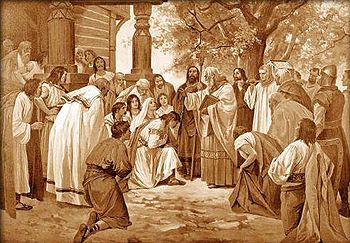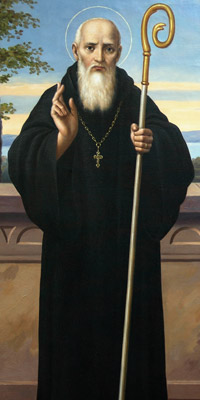 Faith & Worship
Faith & Worship
The early heroes of the faith such as St Jerome, St Ambrose and St Augustine all had experience of manasticism as an antidote to the excessed of the material world. It has to be remembered that the world in which these men walked was marked by a hedonistic lifestyle that we would recognise as being contemporary with our own, particularly in regard to sexuality.
Those who followed the path to monasticism were, said Orosius, 'Christians who, having renounced the multifarious activities concerned with worldy things, confine them to the work of the faith.'
The monastic movement seems to have its origins in Egypt and soon attracted a man called Anthony around AD305 who the story says followed Jesus' entreatment to 'sell all you have and give it to the poor, and come, follow me!' He withdrew to the desert and battled with his own personal demons. The story has it that the devil appeared to him but Anthony resisted. His holiness attracted others, and he organised them into a community of hermits living to a rule of life.
These first monks were essentially solitary individuals who lived in caves, huts or in the desert. Occasionally their behavior became extreme. Symeon Stylites lived for a while atop a pillar some 40 cubits high. Others lived in trees or had weights attached to the necks and limbs.
Palladius was a monk from Palestine who, in 388, went to Egypt to drink in the spirit of monasticism at the fountainhead. On landing at Alexandria he put himself in the hands of a priest named Isidore, who in early life had been a hermit at Nitria and now apparently presided over a hospice at Alexandria without in any way abating the austerity of his life. By the advice of Isidore, Palladius placed himself under the direction of a hermit named Dorotheus who lived six miles outside Alexandria, with whom he was to pass three years learning to subdue his passions and then to return to Isidore to receive higher spiritual knowledge. This Dorotheus spent the whole day collecting stones to build cells for other hermits, and the whole night weaving ropes out of palm leaves. He never lay down to sleep, though slumber sometimes overtook him while working or eating. Palladius who seems to have lived in his cell, ascertained from other solitaries that this had been his custom from his youth upwards.
At the heart of monasticism was separation. A surrendering of earthly riches and temptation and entering into a community of meditation and prayer. Hermits gathered communities of of disciples around them, who followed particular rules of life. Such communities spread form Egypt to Syria, Greece and Palestine, and onward to the western Mediterranean. In AD415 John Cassian, a Scythian who had visited Egyptian monasteries and settled in Bethlehem moved to Marseilles and founded 2 monasteries. St Honoratus did the same on the island of Lérins near Cannes, from where the monastic movement spread to Spain and Ireland, particularly in the late 5th and 6th centuries.
 In
the West, the Rule
of St Benedict prevailed, although little is actually known about
the man himself. This rule of life stressed the quality of mercy toward
the weak and sick, alonside a life of prayer and meditation. a book of
precepts written by St. Benedict of Nursia for monks living communally
under the authority of an abbot. Since about the 7th century it has also
been adopted by communities of women. During the 1500 years of its existence,
it has become the leading guide in Western Christianity for monastic living
in community.
In
the West, the Rule
of St Benedict prevailed, although little is actually known about
the man himself. This rule of life stressed the quality of mercy toward
the weak and sick, alonside a life of prayer and meditation. a book of
precepts written by St. Benedict of Nursia for monks living communally
under the authority of an abbot. Since about the 7th century it has also
been adopted by communities of women. During the 1500 years of its existence,
it has become the leading guide in Western Christianity for monastic living
in community.
The spirit of St Benedict's Rule is summed up in the motto of the Benedictine Confederation: pax ("peace") and the traditional ora et labora ("pray and work").
The Rule of Saint Benedict has been used by Benedictines for fifteen centuries, and thus St. Benedict is sometimes regarded as the founder of Western monasticism. There is, however, no evidence to suggest that Benedict intended to found a religious order. Not until the later Middle Ages is there mention of an "Order of Saint Benedict". His Rule is written as a guide for individual, autonomous communities; and to this day all Benedictine Houses (and the Congregations in which they have associated themselves) remain self-governing.
St Benedict's model for the monastic life was the family, with the abbot as father and all the monks as brothers. Priesthood was not initially an important part of Benedictine monasticism – monks used the services of their local priest. Because of this, almost all the Rule is applicable to communities of women under the authority of an abbess.
St Benedict's Rule organises the monastic day into regular periods of communal and private prayer, sleep, spiritual reading, and manual labour – ut in omnibus glorificetur Deus, "that in all [things] God may be glorified" (cf. Rule ch. 57.9). In later centuries, intellectual work and teaching took the place of farming, crafts, or other forms of manual labour for many – if not most – Benedictines.
Traditionally, the daily life of the Benedictine revolved around the eight canonical hours. The monastic timetable or Horarium would begin at midnight with the service, or "office", of Matins (today also called the Office of Readings), followed by the morning office of Lauds at 3am. Before the advent of wax candles in the 14th century, this office was said in the dark or with minimal lighting; and monks were expected to memorise everything.
These services could be very long, sometimes lasting till dawn, but usually consisted of a chant, three antiphons, three psalms, and three lessons, along with celebrations of any local saints' days. Afterwards the monks would retire for a few hours of sleep and then rise at 6am to wash and attend the office of Prime. They then gathered in Chapter to receive instructions for the day and to attend to any judicial business.
Then came private Mass or spiritual reading or work until 9am when the office of Terce was said, and then High Mass. At noon came the office of Sext and the midday meal. After a brief period of communal recreation, the monk could retire to rest until the office of None at 3pm. This was followed by farming and housekeeping work until after twilight, the evening prayer of Vespers at 6pm, then the night prayer of Compline at 9pm, and off to blessed bed before beginning the cycle again. In modern times, this timetable is often changed to accommodate any apostolate outside the monastic enclosure (e.g. the running of a school or parish). (source Wikipedia)
References
Green, Vivian: A New History of Christianity, Sutton Publishing Ltd
Various Wikipedia articles (OK, I admit I'm not a proper historian!)

©John Birch · Prayers written by the author may be copied freely for worship. If reproduced elsewhere please acknowledge author/website
Privacy Policy · Links · Author · Donate